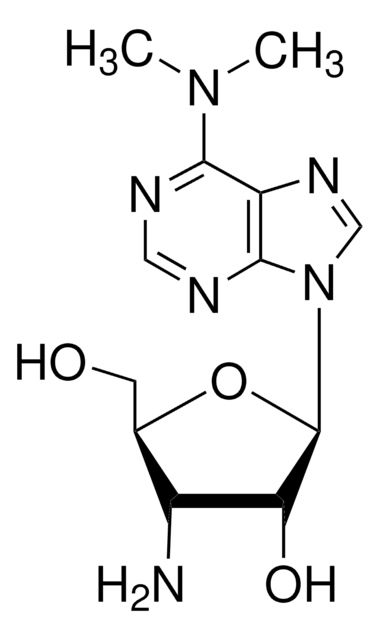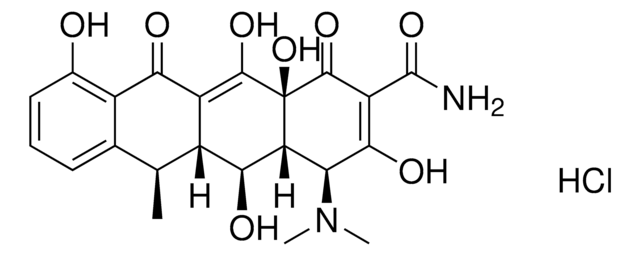SBR00017
Puromycin aminonucleoside Ready Made Solution
10 mg/mL in water
Sinónimos:
3′-Amino-3′-deoxy-N6,N6-dimethyladenosine
About This Item
Productos recomendados
assay
≥98%
Quality Level
form
liquid
concentration
10 mg/mL in water
antibiotic activity spectrum
Gram-positive bacteria
neoplastics
parasites
mode of action
protein synthesis | interferes
storage temp.
2-8°C
SMILES string
N[C@H]1[C@@H](O)[C@H](N(C=N2)C3=C2C(N(C)C)=NC=N3)O[C@@H]1CO
InChI
1S/C12H18N6O3/c1-17(2)10-8-11(15-4-14-10)18(5-16-8)12-9(20)7(13)6(3-19)21-12/h4-7,9,12,19-20H,3,13H2,1-2H3
InChI key
RYSMHWILUNYBFW-UHFFFAOYSA-N
Biochem/physiol Actions
Puromycin aminonucleoside has also been used to probe endothelial glycosaminoglycan synthesis in cultured glomerular endothelial cells and their relation to cell permeability. A puromycin aminonucleoside nephrosis model of rat glomerular disease was also used to study the role of the neuron-specific ubiquitin C-terminal hydrolase protein gene product 9.5 (PGP 9.5).
Preparation Note
Storage Class
10 - Combustible liquids
wgk_germany
WGK 2
flash_point_f
Not applicable
flash_point_c
Not applicable
Elija entre una de las versiones más recientes:
Certificados de análisis (COA)
¿No ve la versión correcta?
Si necesita una versión concreta, puede buscar un certificado específico por el número de lote.
¿Ya tiene este producto?
Encuentre la documentación para los productos que ha comprado recientemente en la Biblioteca de documentos.
Los clientes también vieron
Nuestro equipo de científicos tiene experiencia en todas las áreas de investigación: Ciencias de la vida, Ciencia de los materiales, Síntesis química, Cromatografía, Analítica y muchas otras.
Póngase en contacto con el Servicio técnico








